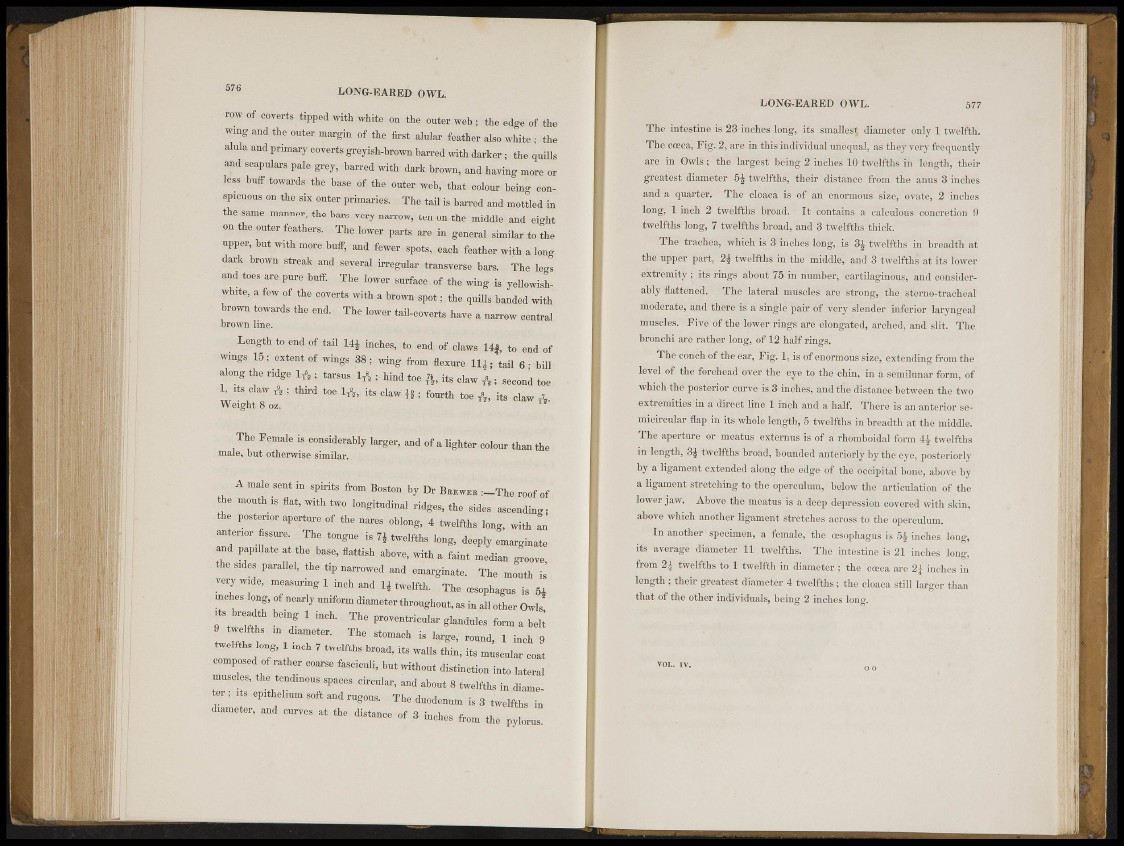
576 LONG-BARED OWL.
-row of coverts tipped with white on the outer web ; the , . ^ e of the
m d U u ' o u t " r « » « f a »<• a e first alulur feather also whi t e the
alula and primary «Herts greyish-brown barred with darker; the quills
and scapulars, pale m , barred wife dark brown, and -having mo » or
, ¿ ^ buff towards the base of the pptefcweb, tbat colour being con-
S p ,CT 1 0 "S 0 B t h 0 s & outer primaries. The tail is barred and mottled in
the same manner, the bars very namnv, ten on the middle and eight
on the outer leathers. The lower parts are in general similar to the
upper, but with n,ore bull; and fewer »pot*, each feather with along
d a k brown streak and several, irregular transverse bars. The legs
and-toe^ are pure b«fl>. The lower .sjjrfac^of the wing is yellowishwlme,
a few of the „overt* with a brown spot: the quills banded with
brown towards the end. The lower tail-coverts have a narrow central
brown line.
Length to end-of tail 1-1* inches, ^ « « I f claws 14|, to end of
» n g s 15; extent;« wings 38; wing from flexure 1 1 t a i l 6 • bill
along the ridge 1 A ; tarsus 1 A , himi t 0 ( ! ft, i t s c l | w ^ ; ^ ^
1, ita claw A ; third toe 1 , ^ . * ™ - « ; fourth H its c l awH
The Female is considerftbly larger, and of a lighter colour than the
male, but otherwise similar.
A male s ?nt in spirits from,Boston by Br LI IT EWER :_Theroof of
m " . " " thi s .flat, with two longitudinal ridges, the side,.: ascending;
the postmor aperture of the „„res oblong, 4 twelfths long, with ah
• • l I H i S ^ ^ ^ emarginate
and papillate at the base,flattish above, with a faint media» l o v e
the sides parallel, the tip narrowed .and emargkate, The • i8'
§ U i ^ B 1 » < * • 4 twelfth, The flesophagus is 1
mches long$;rf nearly uniform diameter throughout, as in all other Owk
xts brerttt being 1 inch. The proventricular glandules form a boh' ' M • • St°maeh 1 • • 1 inch 9
twelfths long, 1 inch 7 twelfths broad, H H H H H M
composed of rather coarse fasciculi, butwithout distinction into lateral
mus c l e the tendinous spaces circular, and about 8 twelfths in.diame-
• | B B S « m g * B • • is 3 twelfth in
diameter, and curves at<the distance• of 3,inches fr„m a e p y l o r a s
LONG-EARED OWL. 577
The intestine is 23 inches long, its smallest diameter only 1 twelfth.
The 'cceea, Fig. 2, are in this individual unequal, as they very frequently
aie in Owls ; the largest being 2: inches 10 twelfths in length, their
greatest diaaMter 5 | twelfths; their distance from the anus 3 inches
and a quarter» The cloaca is (if an enormous size, ovate, 2 inches
R i 1 2 twelfths broad. It tfintains a calculous concretion 4
twelfths long, 7 twelfths broad, and 3 twelfths thick."
Tile trachea, which is 3 inches long, is twelfths in breadth at
till' upper part, 2-j twelfths in the middle,: and 3 twelfths" at its lower
extremity ; Its rings about 75 in number,, cartilaginous, and considerably
flattBiied. ThpHateral. muscles are strong, the sterno-tracheal
moderate, and there is a sinffe pair of ¥«ry slender inferior laryngeal
mnselK Five of the lower rings are elongated, arched, and slit. The
bronchi are rather long, of 12 half rings.
The conch of the ear. Fig. 1. is Of enormous Size, extending from the
level .I{%tho forehead over the eyCto the chin, in a semilunar form, of
which the posterior curve is 3 inches, ami tlio distance between the two
extremities in a direct Ijtfc 1 inch and a half. There is an anterior semicircular
flag in its whole length, 5 twelfths in breadth at the middle:
The aperture or meatus externus is of a rlmmboidal form 4J twelfths:
in length, ty twelfths broad, bounded anteriorly by the eye, posteriorly
by a ligament extended along; the edge of the occipital bone, above by
a ligament stretching to the operculum, below the articulation of the
lower jrt'w. Above the meatus®» deep depression covered with skin,
above which another ligament stretches across to the operculum.
In another specimen, a female, the resophagus is ~>i inches long,
it® average diamuf«r 11 twelfths. Thé intestine is 21 inches long,
from 2,] twelfths to 1 twelfth in diameter : the coeca arc 2f inches in
lengiii; their uroalost diameter 4 twelfths; the cloaca still larger than
that of the other individuals, being 2 inches long.
VOL. IV.